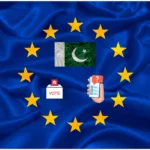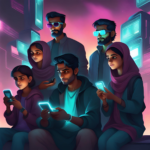The Pakistani film industry is experiencing a come back riding the tide of globalisation and media liberalisation. It is the contention of this essay that one important impact of changing political times and indeed turmoil has been on Pakistani culture. A notion ably depicted by the changing narratives, production values and identity crisis in Pakistani films. It is a truism that the country since independence in 1947, has been characterised by hybrid forms and an unresolved struggle between authoritarian legacies and democratic aspirations (Malik, 1996), thus the changes in cinema can be taken as a cultural manifestation of this inner conflict. In order to illustrate this the essay will hi light two very popular works of director Shoaib Mansoor; one a television drama Alpha Bravo Charlie (1998) based on the lives of officers in the Pakistan army and two, a post-911 highest grossing Pakistani film, Khuda Ke Liye (2007) (In the name of God). Since both films were supported by the Inter-Services Intelligence Public Relations (ISPR), the propaganda arm of the military intelligence, the author intends to further two lines of arguments; firstly that the authoritarian establishment has used cinema as a medium to legitimise cultural hegemony. Secondly, the author explains how the increasing sophistication of the second film requires a poststructural analysis of the film produced in a nation state reacting to global changes.
Background
The praetorianism of the Pakistan armed forces is a well established phenomenon analysed as it’s political economy by Ayesha Siddia (2007) in Military Inc. Inside Pakistan’s Political Economy. In the book she gives a detailed empirical account and consequence of ‘Milbus’ the definition of which is;
military capital used for the personal benefit of the military fraternity, especially the officer cadre, which is not recorded as part of the defence budget or does not follow the normal accountability procedures of the state, making it an independent genre of capital. It is either controlled by the military or under its implicit or explicit patronage. (Siddiqa 2007, p.4)
In her study she makes the assessment that Pakistan army’s increase in economic activities has been directly proportional to its political power and the widespread securitisation of the society. Indeed its two major welfare organisations are also the two biggest companies in the country. It has major assets and investments (monopolies in certain cases) in fertiliser, cement, banking, highway construction and ports. These ‘new land barons’ have preferential decision making power which is detrimental to free-market economics. This has made the Pakistani army among the ten largest armed forces in the world and its officer cadres and retired forces personnel the most powerful fraternity in the country. Moreover, other societal elites have become coalition partners with the Milbus forming what is referred to in the media as the Establishment. Why the Pakistan security state has morphed in to such an existence is beyond the scope of this paper. What is important however are the cultural manifestations of a state dominated by a militarised ruling oligarchy since it tries to shape the state according to a blueprint that suits the interests of a handful of people. And the power to continue shaping the ‘modes of production’ is even more pronounced in postcolonial states like Pakistan. Although the military establishment comprising mainly of the Army and the bureaucracy have been firmly entrenched in politics, economics and foreign policy it wasn’t until the the 1980’s that it came out as an all encompassing financially independent institution of the Pakistani state. This was due to the Soviet-Afghan war where the state became a crucial partner in the United States Cold War. What followed was an influx of American and Saudi weapons and money in to Pakistan with the ultimate aim to train the mujahideen in their guerrilla war. The country became as Tariq Ali has said a ‘U.S Satrapy’. But it was the acquiring of nuclear weapons capabilities in 1998 and the resulting adventures in Kargil in 1999; a move to take over occupied Indian Kashmir by force, that really set the conditions for certain cultural products to take shape.
Alpha Bravo Charlie and Gramsci
The series, Alpha Bravo Charlie was aired on 8pm prime time on Pakistan Television Corporation (PTV), the dominant state station, between May to July 1998. It quickly became the most watched drama serial at the time, not least because of lack of choices for the audience. It was a story of the lives of three young and ambitious recruits in the Pakistan army. Faraz Ahmed a handsome intelligent son of a rich land owning Punjab (largest province of Pakistan) family who after graduating is not assigned to active combat duty but is relegated to a dignified three-star General rank as he opens up a charity school from his resources. Kashif Kirmani is an active duty son of a two-star General. Brave, bold and with a high sense of humour he is promoted to the rank of Captain. Upon graduation he is assigned to a post on the Siachen glacier, one of the highest battlegrounds in the world and an area of strategic importance in the Kashmir dispute. It was also one of the battlegrounds during the Kargil conflict. As the series builds up, Kirmani takes a dangerous mission and destroys the Indian enemy but is wounded during the skirmish. He spends three days in the snow before finally getting rescued but tragically has his limbs amputed as a result of injuries. For his valour he is given an honourable discharge which he refuses and continues to serve in the army. Lastly, Gulsher Khan is a shy, mild mannered Captain and a son of a petty officer in the army. Occupying a rank higher than his poor father and clearly coming from a modest upbringing Khan’s story is that of the coming of age of a young man on a steady upward social mobility. Khan is sent to Bosnia on a U.N peacekeeping mission where he launches rescue operations to protect Bosnian Muslims held by Serbian forces. There he starts to command the respect of the locals and one Bosnian woman proposes to marry him which he respectfully refuses being already a married man. As the series unfolds Khan is captured in a Serbian ambush and gets killed while attempting to escape.
Lets first establish the notion that cultural hegemony has been an important aspect of state narrative of Pakistan’s history and ideology as a home for Muslims of the Subcontinent. The architects of Pakistan, most of which belonged to the landed gentry in the patronage of the British Raj realised that religious sentiments could become the only political slogan that could unite what Partha Chatterjee has termed the ‘political society’ in subaltern literature, under one banner in the fight for independence. This nation-state narrative has been controlled by the elites of the Pakistani society since then. Thus the revision of history books, discouragement of alternate national discourse in the media, indirect control of the Urdu newspapers by intelligence agencies due to its widespread readership and heavy censorship imposed on English newspapers (the preferred newspapers of upper-middleclass), suppression of provincial nationalist voices and minorities has becomes a necessary outcome of the ideological apparatus. Viewed form this light, the Establishment is a physical and metaphorical representation of what the societal elites have come to be understood in Pakistan, its most powerful player being the army. Siddiqa’s work as a military strategist has been of empirically grounding the exact nature of the expanding politico-economic reach of the Establishment. Her work sets the ground for a critique of an ideological state apparatus and indeed for this TV series as an important propaganda tool deployed as a ‘soft power’ initiative to legitimise states ventures in Kashmir. It is hard to dismiss the timeliness of broadcast as mere coincidence. Antonio Gramsci’s notion of cultural hegemony is a good starting point to conceptualise this:
One can say that not only the philosophy of praxis (Marxism) not exclude ethico-political history, but that indeed in its most recent stage of development, it consists precisely in asserting the moment of hegemony as essential to its conception of the state and to the accrediting of the cultural fact, of cultural activity of a cultural front as necessary alongside the merely economic and political ones.
The incursions in Siachen and its possible repercussions, a critical analysis of the perceived threat to Islam in Bosnia, the pervasiveness of the military in general gets lost within the static of a beautiful portrayal and slice of life depicted in the TV series. Instead, we have a ‘good will’ TV series with a superb production value and cannot help put invest ourselves emotionally in the characters; Faraz for his charitable appeal, Kashif for his patriotism and tragic loss, Khan for his ‘nice-guys-finish-last’ aura. The death of Khan in the final episode is particularly unsettling as it portrays him as a poor victim caught between events outside his control. He really becomes a martyr, a saint and ultimately symbolises his institution. We must venerate him, we must absolve him for any sins he might have committed. With its firm grip over any and all forms of media broadcast and distribution it became that much easier for the state to promote this cultural product. Since only four television channels existed in the country, all state owned, before 2002 and since internet was barely present the series faced zero threats from competing television programs or critical reviews from the civil society.
It is really the liberalisation of the Pakistani media industry after 1999 following, but not limited to, what the then Minister of Information Javed Jabbar has attributed as “counter(ing) increasing Indian propaganda”1 which demonstrates for us the continuity of this cultural hegemony. But very soon we realise that cultural hegemony is no longer an accurate term of the functioning of the ideological state apparatus and I will explain why in a bit. Here I would like to bring to attention two significant events relevant to our discussion. Firstly, ‘liberalisation’ here means not just of the media industry but the liberal market policies adopted by the dictatorship of President General Pervez Musharraf2 which included privatisation, opening of Pakistan economy for international investment and of course unprecedented investment in the telecommunication, news media industry. The economy managed by a cadre of experts in a highly centralized bureaucracy did indeed experience rampant growth within the first few years of military rule and achieved some modicum of stability. It is my contention that this period marks Pakistan’s formal entry (if ever there was such a thing) in to globalisation and postmodernity. Secondly, the September 11 attacks and the subsequent invasion of the U.S in Afghanistan had widespread repercussions for the Pakistani establishment; it now found itself forced to dismantle the same mujahideen network, founded to fight the Soviets, by the same allies that had funded it. The same mujahideen network that was now labelled in the U.S media as a terrorist network. This resulted in a massive dissonance within not only the Establishment but the rest of the society; in the 80’s the narrative of the mujahideen (transliterated here as a ‘religious freedom fighter’) went well with the Pakistani nation-state identity i.e. a state for the muslims of the Subcontinent and thus appealed to the popular sentiments of the subaltern. Ultimately this combination resulted in the adoption of a puritanical Islamic thought since it served as a convenient method for the Establishment to set in motion an ideological state apparatus. Indeed, the period in the 80’s is colloquially known as Islamization of Pakistan. Now however in participating in the ‘War on Terror’ and the various financial opportunities it provided the ideological state apparatus found itself in need of a recalibration. President General Musharraf then attempted to introduce his ‘Enlightened Moderation’ policy and drew many parallels of Pakistan with Turkey. However, this time around the ideological state apparatus did not work as ‘effectively’ due to creeping globalisation and mediatization3 of the society. By effectively I mean that this conceptualisation of cultural hegemony is inadequate. In a sense, I want to argue that globalisation has brought with it an increasing salience of postmodern/poststructural theories as a lens to look at some aspects of Pakistani society. Which brings us to our second film.
Khuda Ke Liye (In the name of God)
The plot follows the lives of a family of upper-middle class Pakistanis across three countries. A handsome duo, Mansoor and Sarmad are brothers who are part of a rising musical band in Lahore, Pakistan. Sarmad becomes increasingly influenced by the rhetoric of a prominent local muslim cleric who had earlier played an active role in the Afghan War and is now running an insurgency against the Americans in Afghanistan. He starts sporting a beard, drops out of the band, starts attending religious sermons and even pressures his free-spirited family to also follow his new lifestyle. Mansoor, not deterred by the inner conflict of his brother, travels to Chicago to pursue studies in music. He adjusts well with the diverse community of students and is celebrated as a talented musician. He also falls in love with a girl called Janie who quits alcohol for him and they eventually get married. Meanwhile in England, Mary/Mariam is a young Pakistani girl born and raised in Britain whose first generation progressive albeit hypocritical father brings her to Pakistan on a pretext and forcefully marries her off in a village. The story then unfolds as the world witnesses 9/11. Mansoor is taken in custody without trial by the U.S intelligence agencies and is tortured to Insanity. Sarmad reluctantly travels to Afghanistan to fight a ‘holy war’ and returns traumatised. While Mary, now rescued by the Pakistan Army under orders from the British government takes her father to court. The court scene is the essence of the film where an argument unfolds and where another religious cleric explains how a particular brand of Islam is being exploited to instigate hatred while the message of tranquility and peace is getting lost in the clutter.
Reception
The film was released to widespread critical appreciation and fame in 2007, squarely in the middle of military operations being conducted against the by now belligerent and dangerous Islamic militancy in north west of Pakistan. It quickly became the highest grossing film in Pakistani cinema which is a feat that must be emphasised; a cast of popular television stars, script by acclaimed director Shoaib Mansoor, promotion by Geo Network (a byproduct of media liberalisation), shooting done on location and many other firsts, were a testament to the high production value. Most importantly many Pakistanis were indeed proud of a film that resonated with their identity crisis and moreover, its positive reception around the world was viewed as an empathetic acknowledgment of this identity crisis and marginalization. The film however does seem to be an anomaly since the cinema industry in Pakistan had all but vanished, due to unfavourable economic policies and Islamization by the time of its release. Also many Bollywood veterans have been concerned about the films actual market value if left on its own in a South Asian market; the film performed average at the Indian box office where an audience is used to grandiose, item-numbers, big stars, spontaneous dancing and idealistic notions of love. Finally, the film was aired for free on Geo Television, which is now the most watched television after PTV, which raises doubts regarding profit motives behind its production; most independent and international Pakistani film directors do not release their films in the fledgling Pakistani market.
A new framework of hegemony?
Did the film work if it had a political purpose? I would argue that the film itself is a political message. By tackling issues of gender discrimination as in the case of Mary, issues of identity crisis experienced by upwardly mobile Pakistani families and the ideological clash between certain sects of Islam the film successfully hi lights the symptoms of societal fissures in a young nation state. But because this political message is limited to this humanist projection it will never appeal to our critical senses as it falls just short of explicating possible causes for societal fissures, gender discrimination and ideological conflicts. Although in one sense, if we look at it through the ideological state of Gramsci, this does represent progress because an overt categorisation of a ‘root-of-evil’ and hence propaganda, as depicted in Alpha Bravo Charlie, is absent. However I would argue that precisely because of this nuanced approach to sensitive issues, the film hints at the inevitability of such societal fissures. In other words by taking the cause out of the equation the film absolves the embedded power structures which otherwise may be revealed as the cause of this inevitability. I should not be too harsh on the director though after all this film represents an important cultural milestone in Pakistani history, riding though on the back of mediatization, and having an almost emancipatory effect on the Pakistani consciousness. However one can’t help but reflect on the complete involvement of Pakistani armed forces in every sphere of the security state (see discussion of Siddiqa earlier) which also happens to be a transitioning democracy and is perhaps giving new forms of socio-political and economic structures that haven’t been conceptualized yet. Perhaps the term Establishment as it was understood 20 years ago does not hold currency any more. It is no longer strictly an elitist super structure, with a rural population at its base; there is now a middle class that now stands at 28% many members of which are connected to varying degrees with the Establishment. I realize this is a rather reductionist viewpoint and has been mentioned only for illustrative purposes. This is a similar concern as that of Spivak when she talks about catachresis. The point is that there is a core which pulls the society proper towards it with a powerful force. Cultural products like Khuda Ke Liye do not represent Islamic moderation or for that matter radicalization, they exist to serve a purpose in the changing nature of what Siddiqa now refers as a ‘hybrid-theocratic state’, as and when it deems necessary.










